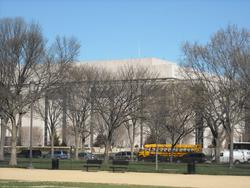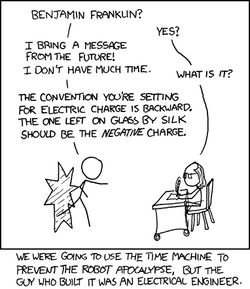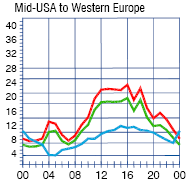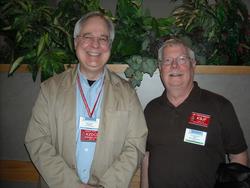 April 15, 2009 Editor: Ward Silver, NØAX | |||||
IN THIS ISSUE
NEW HF OPERATORS - THINGS TO DO If you haven't sipped the nectar of a state QSO party yet, give the Florida QSO Party a squeeze. This is one of the larger events with many mobile and fixed stations active. In between picking Florida oranges, the MI, NE, and VE3 contests all occur on the next two weekends. You'll have no trouble finding them! BULLETINS No bulletins in this issue. BUSTED QSOS How could the April Fool's issue be golden - wouldn't that have been a contradiction in terms? David WA1OUI reports that, contrary to the report, IRC's "...are not always easy to get, but I just ordered some from my local Post Office." Complete information is available in section 380 of the USPS International Main Manual. (Thanks also, Joe W4TV) CONTEST SUMMARY Complete information for all contests follows the Conversation section April 18-19
April 25-26
NEWS, PRESS RELEASES, AND GENERAL INTEREST As Dayton looms ever larger, keep the Contest Super Suites firmly in your sights, beginning on Wednesday night! Feed your inner Pizzamaniac as you celebrate the 50th anniversary of the CQWW Multi-Multi category. (Thanks, Tim K3LR) QRP contesters should consider a visit to the QRP ARCI's "Four Days In May", held just prior to the Dayton Hamvention. Speakers for this year include Rick Campbell KK7B, Ed Hare W1RFI, George Dobbs G3RJV, Oleg Borodin RV3GM, Dave Cripes NMØS, and Jan Verduyn GØBBL. The topics will cover Softrock Radio, Class E Amps, QRP in Russia, Test Equipment, and some great humor and interesting tales. With RTTY contesting the fastest-growing aspect of radiosport, there are bound to be a lot of new RTTY contesters. With that in mind, Dayton RTTY Forum moderator Shelby K4WW announces, "The Dayton RTTY forum will have a panel discussion on how best to accommodate the diversity of participants in RTTY contests. The vast majority of participants are not super-serious competitors and may only be on for a few contacts to work a new state/province/country or to try out their station or simply to enjoy some RTTY contacts which are more scarce outside of contest periods. Each panelist will give a short statement of their perspective on participant diversity in RTTY contests and then be available to address questions and comments from the audience. Panelists will include K5DU, K4GMH, W2QO, and K4IA."
More good stuff! Scott KA9FOX reminds the Contest Update readers that since the ARRL stopped running their classified ad service, the QTH.com e-flea market is a recommended destination for the ham shopper. The Super Check Partial files have moved to a new Web site - www.supercheckpartial.com. There are now 46,695 different calls in the master file. The masterdx.dta file no longer includes any VE calls. (They are in the master file, of course, just not in the DX file.) File manager, Randy K5ZD, says, "I am moving the SCP files off of my personal Web site and on to their own. This will enable a consistent Web address for the files going forward. It may also enable some options for how to upload files in the future." The Do It Yourself movement is by no means constrained to the Pacific side of the Atlantic. Maker Faire UK was held recently and deemed a big success. Here in the United States, Maker Faire will be held in the San Francisco Bay area over the Memorial Day weekend, with a bigger ham radio presence than ever before. Genesis Radio from Australia has introduced their 5-watt Software Defined Radio transceiver kit, the G40. It's a single-band kit for 40 meters and connects to a host PC's sound card for the digital part of the signal processing. Multi-band radios, as well as a 2 meter version, are in the works. With the modulation and demodulation being done by software, radios like this one are serving as a springboard for amateur experimentation and innovation. Speaking of 40 meters, while "hope springs eternal" as all baseball fans know, our euphoria stemming from the emigration of Region I shortwave broadcasters away from 7100-7200 kHz must be somewhat tempered by the situation farther west (or east, depending on your point of view). The band has cleared up considerably east of the Mississippi, but ITU Region III broadcasters apparently aren't going anywhere, according to reports from around the Pacific Rim and deep into the 5th and 10th US call areas. Carriers are still pounding in every 5 kHz from 7100 to 7200. Illegal they may be, but so is the over-the-horizon radar emanating from Zone 24. As Shel Silverstein once wrote, "This just might take some time..." (Thanks, Brett VR2BG and others) Gary KE7DX notes that while there is a 7th district regional QSO Party (the 7QP contest coming up in a few weeks) covering Arizona, the single-state Arizona QSO Party hasn't been run in a few years. How about one of those Arizona contest clubs taking up the flag and putting one on for the Year Of the State QSO Party? There's lots of 2009 left! From AMSAT News Service Bulletin ANS-102, the UK regulatory equivalent of the FCC, Ofcom, has published a document about the effects of interference to UHF & SHF communications by wind farms. Single turbines are said to produce up to 3 dB fading and a full farm can create short fades of up to 15 dB. VHF+ contesters might put this to work in reverse by using the large blades as a reflector, instead! Here's a neat game called "Time Engineers" for your technically-minded youth in which kids travel through time to solve various engineering problems of the day with appropriate materials and techniques. (from Embedded System Design, April 2009) Web Site of the Week - This editorial on science education by Mythbuster maven Adam Savage, is good reading. Essentially, the message is "do", "support", and "make mistakes" - the basic requirements for ham radio and radiosport - just as this team of students did as they snapped some pictures from 100,000 feet overhead. WORD TO THE WISE Ethics - according to Contest University instructor and WPX Contest Director, Randy K5ZD, "It's what you do when no one is watching." 'Nuff said. SIGHTS AND SOUNDS Got space for another multiplier? Sooner or later, there will be an "Orbit" multiplier and this short Flash animation shows where it's going to come from. I can't wait for the "Ham Shack" module to be installed! (Thanks, Steve K7LXC)
Electronic-ers of all ages have suffered from cognitive dissonance as they struggle with the age-old confusion of conventional versus electronic current. Is the right-hand rule or the left-hand rule? Does the arrow point in or out? Is backwards really forwards? Ouch! Oh, if only Benjamin Franklin could have chosen the other polarity as this XKCD cartoon wistfully wishes. Pretty much all of contesting depends on an electric socket somewhere, sooner or later. For those readers interested in what lies ahead for what lies behind the place where you plug your prongs, Renewable Energy World published this podcast on the "Smart Grid". How low can you go, indeed! A pair of enterprising fellows - W1HIS and G4MSF spanned the Atlantic in 2003 using a pair of WWII tank transceivers. While "crossing the pond" with flea power is not particularly unusual, using these radios to do it is. Designed for short-range, strong-signal communication, there is not a quartz crystal to be found in either of them and their selectivity and dynamic range, shall we say, do not challenge any modern receiver. Imagine how future hams will feel about our stations today? How high can you go? Wouldn't a 75-meter freestanding tower look good in the back yard? Take a look at Sasha UT7UV's tower going up! (Thanks, Hal W1NN) RESULTS AND RECORDS ARRL Contest Branch Manager, Sean KX9X announces that the results for the 2008 ARRL November CW Sweepstakes are now online. You'll enjoy author Kelly VE4XT's informative and personable write-up. Watch for the SSB Sweepstakes article to be online soon with the ARRL Affiliated Club competition results. Due to a problem with the log reception script not being set-up properly, many emailed logs for the JIDX-CW contest were returned as "user unknown". This has been fixed, so if your log was returned, please re-send your log to cw@jidx.org. (Thanks, Tack JE1CKA/KHØAM) OPERATING TIP As you become more proficient in using a keyboard and your logging program, performance improvements become more subtle. Here's a way to remove an impediment to progress - program your function keys with the same messages for every contest (except for the exchange elements, of course). By making those functions consistent, they become "automatic", freeing you to think about and do other things. TECHNICAL TOPICS AND INFORMATION If you're an apartment dweller or don't have room or the budget for a shop full of tools, look in to "hacker spaces". Those photos look pretty attractive to me. Not only would these be a great place for you to work, but also learn from others and have an opportunity to teach them, too. When you answer, "Building an remote-control mobile antenna tuner," to the inevitable queries, what better time to introduce someone to amateur radio?
An important part of creating an operating plan is planning for propagation. If you need a general set of propagation charts in a hurry or you're away from the computer with the propagation software, try the online monthly propagation charts from the ARRL. For fun and review, charts are available back to 2006. (Thanks, Larry N6NC) We've all gotten those, "I'll bet you get good TV reception on those, um, aerials!?" comments from the astute passerby. Well, here's a reason to catch them at their own game and say, "As a matter of fact, I do!" Kent WA5VJB, famous for his "Cheap Yagi" design has created this little beauty of a beam for HDTV reception. The new digital signals probably won't reach a lot of folks in fringe areas - the external antenna may be about to return to the landscape! Rus K2UA and Mark K6UFO relay the stunning news from Space Weather News for April 2, 2009 that "NASA announced that the sun has plunged into the deepest solar minimum in nearly a century. Sunspots have all but vanished and consequently the sun has become very quiet." Really? I hadn't noticed! Seriously, they do go on to say that in similarly deep minima, the next cycle has bounced back to a robust peak. (For instance, the fabled Cycle 19, perhaps.) Hams, like the proverbial canaries in the coal mine, are occasionally asphyxiated by "electrosmog" emanating from the ever more ubiquitous digital and switching gadgetry. (And it always seems to be coming from somewhere between you and wherever the band is open.) As product designers know, getting read of those emissions can be difficult, partly because once you get past the "usual suspects", finding out the source of the emanations can be difficult. This Physorg article on a micro-sized EMI sniffer may help them on their quest. Through-hole NMO antenna mounts are common unless you are attempting to attach the antenna to something thicker than automobile body panels. Faced with that conundrum, Lynn N7CFO turned up several candidates by searching on eBay with the appropriate keywords. In Lynn's words, "Lots of neat stuff that I'd never seen before!" Mike K7MDL chimed in with his recommended NMO mount, too.
Jim KK7VL reports finding the fiberglass rods mentioned in the previous issue in larger diameters up to 7/8 inch. The outside diameter of this rod is the same as 3/4 inch copper tube. Couplings slip over the fiberglass rod. This makes constructing antennas easy! Here's a recent weekly "Instructable" projects showing how to make etched aluminum panels all the way through filling the etched letters and calibration marks with paint. This is a good way to repair old gear, as well as make new stuff. Technical Web Site of the Week - The May edition of the Mt Airy VHF Radio Club's "Cheesebits" newsletter points us to the Aubraux "Design Central" Web page. While the Cheesebits article was in regard to an attenuator design program, the site has numerous software design tools, tutorials, and calculator applets. With regard to the attenuator design tool, it accepts the desired terminating impedance and attenuation as inputs and produces the three resistor values needed in both T and Pi configurations. Enjoy! CONVERSATION What Does Radiosport Ask Of Us? Just after the first of the year, columnist David Brooks published a thoughtful piece entitled, "What Life Asks of Us" in which he observes, "... we are not defined by what we ask of life. We are defined by what life asks of us. As we go through life, we travel through institutions -- first family and school, then the institutions of a profession or a craft." This parallels the history of many hams into and through a lifetime of ham radio and, certainly, of contesting. We rely on those institutions to give us guidance, to show us where the "Good Arrow" points, and as a means of determining our successes and failures and those of our peers. As such, we are institutionalists, subjugating our own individual inclinations because we believe in those institutions. As a contester, keeping the institutionalist point of view is quite a challenge. On the one hand, success in our institutions - skill in operating, technical know-how, experience with the environment of radio, ethical behavior - are our benchmark for attaining success, on and off the bands. Immersed in the fast currents of ever-changing technology, the practices through which we achieve that success, however, constantly evolve. Newcomers, making their journeys just as we did, can not possibly be as steeped in lore and tradition as the veterans among us. Yet we sense common bedrock, deep below, however imperfectly and dimly - more by inference than contact. Perhaps it is not so much the institutions themselves, but rather understanding their existence and central role, that makes from all of us, the young and the old, a community. Brooks quotes baseball Hall of Famer Ryne Sandberg from his induction acceptance speech given among his peers and other inductees, "I was in awe every time I walked onto the field. That's respect. I was taught you never, ever disrespect your opponents or your teammates or your organization or your manager and never, ever your uniform. You make a great play, act like you've done it before; get a big hit, look for the third base coach and get ready to run the bases. "These guys sitting up here did not pave the way for the rest of us so that players could swing for the fences every time up and forget how to move a runner over to third. It's disrespectful to them, to you and to the game of baseball that we all played growing up. "Respect. A lot of people say this honor validates my career, but I didn't work hard for validation. I didn't play the game right because I saw a reward at the end of the tunnel. I played it right because that's what you're supposed to do, play it right and with respect ... . If this validates anything, it's that guys who taught me the game ... did what they were supposed to do, and I did what I was supposed to do." Yes, that's it -- respect. It is enough that we share the ability to respect and to exhibit that respect. It bonds us together across generations from the past through to future. The methods and practices and highways and byways may come between us, but in the end, if we each carry a flame of respect somewhere inside, I can look you in the eye and you can look back. And then we'll go on our way, confidently knowing we are doing that which radiosport asks of us. Respectfully, CONTESTS 15 April to 28 April An expanded, downloadable version of QST's Contest Corral in PDF format is available. Check the sponsor's Web site for information on operating time restrictions and other instructions. HF CONTESTS EU Spring Sprints--Phone, from Apr 18 1600Z to Apr 18 1959Z . Bands (MHz): 3.5-14. Frequencies: 3.730, 7.050, 14.250. Exchange: Both callsigns, serial, name. Logs due: 15 days. Rules TARA Skirmish Dig Pfx Contest--Digital, from Apr 18 0000Z to Apr 18 2400Z . Bands (MHz): 1.8-28, 50. Exchange: Name, prefix. Logs due: May 17. Rules Holyland DX Contest--Phone,CW,Digital, from Apr 18 0000Z to Apr 19 2359Z . Bands (MHz): 1.8-28. Exchange: RS(T), serial or Israel district. Logs due: May 31. Rules ES Open HF Championship--Phone,CW, from Apr 18 0500Z to Apr 18 0859Z . Bands (MHz): 3.5,7. Exchange: RS(T), serial, dupes OK once/hour. Logs due: May 20. Rules Michigan QSO Party--Phone,CW, from Apr 18 1600Z to Apr 19 0400Z . Bands (MHz): 3.5-28. Frequencies: CW 45 kHz from band edge, Phone 3.825, 7.200, 14.250, 21.300, 28.450. Exchange: Serial and MI county or S/P/C. Logs due: 30 days. Rules EA QRP Contest--CW, from Apr 18 1700Z to Apr 19 1300Z . Bands (MHz): 3.5-28. Exchange: RST, category, M if EA QRP member. Logs due: 30 days. Rules Ontario QSO Party--Phone,CW, from Apr 18 1800Z to Apr 19 0500Z and Apr 19 1200Z to Apr 19 1800Z . Bands (MHz): 1.8-28, 50,144, Frequencies: CW 30 kHz above band edge; Phone 1.870, 3.735, 3.860, 7.070, 7.260, 14.130, 14.265, 21.260, 28.360; VHF-SSB: 50.130, 52.540, 144.205, 146.550. Exchange: RS(T), S/P/C or Ontario QTH. Logs due: May 31. Rules YU DX Contest--CW, from Apr 18 2100Z to Apr 19 0500Z and Apr 19 0900Z to Apr 19 2100Z. Bands (MHz): 1.8-28. Exchange: RST and ITU zone. Logs due: 30 days. Rules VHF Spring Sprints--Phone,CW, from Apr 22 7 PM to Apr 22 11 PM. Bands (MHz): 432. Exchange: Grid Square (6-character preferred). Logs due: 14 days. Rules SP DX RTTY Contest--Digital, from Apr 25 1200Z to Apr 26 1200Z . Bands (MHz): 3.5-28. Exchange: RST, serial, SP province. Logs due: May 19. Rules Helvetia Contest--Phone,CW,Digital, from Apr 25 1300Z to Apr 26 1259Z . Bands (MHz): 1.8-28. Exchange: RS(T), serial or Swiss canton. Logs due: 31 days. Rules QRP To The Field--CW, from Apr 25 1500Z to Apr 26 0300Z. Bands (MHz): 7-28. Exchange: RST, S/P/C. Logs due: Jun 1. Rules Florida QSO Party--Phone,CW, from Apr 25 1600Z to Apr 26 0159Z and Apr 26 1200Z to Apr 26 2159Z . Bands (MHz): 7-28. Frequencies: CW 7.025-7.035, 14.040-14.050, 21.040-21.050, 28.040-28.050 ; Phone 7.18-7.19, 14.265-14.275, 21.340-21.350, 28.480-28.490. Exchange: RS(T), FL county or S/P/C. Logs due: 30 days. Rules Nebraska QSO Party--Phone,CW,Digital, from Apr 25 1700Z to Apr 26 1700Z . Bands (MHz): 1.8-28, 50,144, Frequencies: CW: 1.805 and 35 kHz above band edge, Nov/Tech--10 kHz above band edge; Phone--1.915, 3.865, 7.265, 14.265, 21.365, 28.465, 146.460. Exchange: RS(T), NE county or S/P/C. Logs due: May 31. Rules VHF+ CONTESTS TARA Skirmish Dig Pfx Contest--Digital, from Apr 18 0000Z to Apr 18 2400Z . Bands (MHz): 1.8-28, 50. Exchange: Name, prefix. Logs due: May 17. Rules Ontario QSO Party--Phone,CW, from Apr 18 1800Z to Apr 19 0500Z and Apr 19 1200Z to Apr 19 1800Z . Bands (MHz): 1.8-28, 50,144, Frequencies: CW 30 kHz above band edge; Phone 1.870, 3.735, 3.860, 7.070, 7.260, 14.130, 14.265, 21.260, 28.360; VHF-SSB: 50.130, 52.540, 144.205, 146.550. Exchange: RS(T), S/P/C or Ontario QTH. Logs due: May 31. Rules VHF Spring Sprints--Phone,CW, from Apr 22 7 PM to Apr 22 11 PM. Bands (MHz): 432. Exchange: Grid Square (6-character preferred). Logs due: 14 days. Rules Nebraska QSO Party--Phone,CW,Digital, from Apr 25 1700Z to Apr 26 1700Z . Bands (MHz): 1.8-28, 50,144, Frequencies: CW: 1.805 and 35 kHz above band edge, Nov/Tech--10 kHz above band edge; Phone--1.915, 3.865, 7.265, 14.265, 21.365, 28.465, 146.460. Exchange: RS(T), NE county or S/P/C. Logs due: May 31. Rules LOG DUE DATES 15 April to 28 April April 15 -- Virginia QSO Party, email logs to: vqp@verizon.net, paper logs and diskettes to: VA QSO Party, Call Box 599, Sterling, VA 20167, USA. Rules April 15 -- RSGB Commonwealth Contest, email logs to: commonwealth.contest@rsgbhfcc.org, paper logs and diskettes to: RSGB-G3UFY, 77 Bensham Manor Road, Thornton Heath, Surrey CR7 7AF, England. Rules April 17 -- Wisconsin QSO Party, email logs to: k9kr@tds.net, paper logs and diskettes to: Wisconsin QSO Party, West Allis Radio Amateur Club, P. O. Box 1072, Milwaukee, WI 53201, USA. Rules April 17 -- SKCC Weekend Sprint, Post log summary at: http://www.skccgroup.com/sprint/wes/wes-submit.html, paper logs and diskettes to: (none). Rules April 21 -- RSGB RoPoCo 1, email logs to: ropoco1.logs@rsgbhfcc.org, paper logs and diskettes to: RSGB G3UFY, 77 Bensham Manor Road, Thornton Heath, Surrey CR7 7AF, England. Rules April 21 -- 9K 15-Meter Contest, email logs to: 9k2rr@9kcc.com, paper logs and diskettes to: Faisal N. Al-Ajmi, 9K2RR, P.O.Box 1124, Alfarwanya 80000, Kuwait. Rules April 21 -- 144 MHz Spring Sprint, email logs to: springsprintlogs@gmail.com, paper logs and diskettes to: 2009 Spring Sprints, c/o Chuck Towner, W9KQJ, PO BOX 73, PALATINE, IL 60078-0073, USA. Rules April 21 -- QRP Homebrewer Sprint, email logs to: w2lj@verizon.net, paper logs and diskettes to: Larry Makoski, W2LJ, 327 Clinton Place, South Plainfield, NJ 07080, USA. Rules April 25 -- EA RTTY Contest, email logs to: rttycontest@ure.es, paper logs and diskettes to: (none). Rules April 26 -- EU Spring Sprint, CW, email logs to: eusprint@kkn.net, paper logs and diskettes to: Dave Lawley, G4BUO, Carramore, Coldharbour Road, Penshurst, Kent TN11 8EX, England. Rules ACKNOWLEDGEMENTS ARRL Contest Update wishes to acknowledge information from WA7BNM's Contest Calendar and SM3CER's Contest Calendar. | |||||










